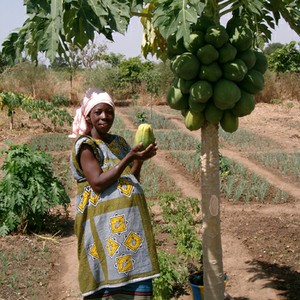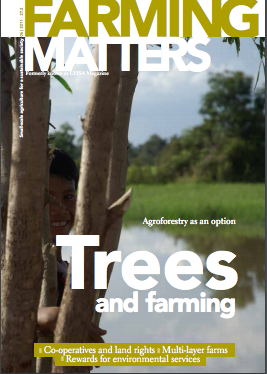The size of the world’s forests is declining every year and yet, at the same time, the number of trees on farms is increasing. Over a billion hectares of agricultural land, almost half of the world’s farmland, have more than 10 percent of their area occupied by trees. Over 160 million hectares have more than 50 percent tree cover. Agroforestry, mixing trees with agriculture, is a crucial bridge between forestry and agriculture. Growing trees on farms can provide farmers with food, income, fodder and medicines, as well providing environmental benefits such as enriching the soil, retaining water, fixing carbon and generating biomass.

Over the next two decades, the world’s population is expected to grow by an average of more than 100 million people a year. More than 95 percent of that increase will occur in developing countries, where pressures on land and water are already intense.
A key challenge facing the international community, as well as local institutions and farming communities is, therefore, to ensure food security for present and future generations, while protecting the natural resource base on which they depend. Trees on farms will be an important element in meeting those challenges.
Farmers in many parts of the world are enthusiastically incorporating trees into their landscapes as the benefits of doing so become clear.
Data from the Food and Agriculture Organization show that the number of trees on farms is increasing, even as the amount of forests is decreasing. In some regions, such as Southeast Asia and in Central America, tree cover on agricultural lands now exceeds 30%.
Multiple benefits from working trees
Agroforestry focuses on the wide range of useful trees that can be grown on farms and in rural landscapes. These include “fertilizer trees” for land regeneration, soil health and food security; fruit trees for nutrition; fodder trees that improve the production of smallholders’ livestock; timber and fuel wood trees for shelter and energy; medicinal trees that combat disease; and trees that produce gums, resins or latex products. Many of these trees are multipurpose, providing a range of benefits.
Agroforestry provides many livelihood and environmental benefits, increasing the assets of poor households with farm-grown trees, enhancing soil fertility and livestock productivity on farms, and linking poor households to markets for high-value fruits, oils, cash crops and medicines. Domesticating wild fruit trees, such as the African plum (Dacryodes edulis) and the bush mango (Irvingia gabonensis), using simple, sustainable technologies like nurseries, soil fertility management and domestication programmes, has allowed smallholder farmers in Cameroon to increase their earnings fivefold. Similarly, a massive communal move to plant poplar trees in irrigated wheat and barley fields in northwest India now supplies 50 percent of the country’s pulp and paper industry. Both cases show the importance of a group effort, in the same way as Jeff Follett’s article from Brazil.
Policy, land rights and ownership of trees
Yet, the contribution that trees can make on farms is strongly influenced by governance institutions, policies and rights. Trees are a long-term crop and farmers need to have secure tenure to their land before they will invest valuable time and resources in growing or nursing trees. They also need rights over the trees themselves. Changes to policies in Kenya that gave farmers ownership of trees on their land have stimulated large new investments in tree planting and care.
For agroforestry to thrive, what is needed is an intensification of the trend to devolve land and forest tenures to local people and complete the transition from exclusion to ownership. Obstacles such as the gap between forest and agricultural policies, a lack of capacity and underinvestment have hindered the widespread adoption of agroforestry.
Sequestering carbon
The United Nations declared 2011 as the International Year of Forests, emphasising the role of forests in the climate change agenda and building on several years of policy progress for Reducing Emissions from Deforestation and forest Degradation (REDD+). Agriculture can reduce emissions, but so can trees in agricultural landscapes. Agroforestry blurs the agriculture-forest divide. However, climate change policies and emerging institutions perpetuate this divide, creating separate rules and incentives to govern each sector. This hinders the potential of agroforestry to play its full role as a major part of the solution to climate change.
Taking the results of a large number of studies (see http://tinyurl.com/6957366), we can confidently say that a tropical tree sequesters at least 22.6 kg of carbon from the atmosphere each year and in many cases much more. Most of the deforestation in Africa, and in parts of Asia, is caused by agricultural expansion, largely by smallholder farmers. Agroforestry can curb emissions of greenhouse gases by slowing the conversion of forest to farm land and holding carbon in the trees on the farms. Developing smallholder agroforestry on land that is not classified as forest could capture 30-40 percent of the emissions related to land-use change.
The long-term perspective
A long-term perspective is essential to meet the future challenges that increasing population will bring, especially that of increasing food supply from a diminishing area of available land. In the longer term, the emerging Evergreen Agriculture movement, which looks to reinvent agriculture trees in a radical, but entirely practical, way, is a vision of a future in which many food crops will be grown under a full canopy of trees. Evergreen Agriculture is doubling and tripling cereal crop yields in many parts of the African continent. The indigenous nitrogen-fixing tree Faidherbia or Acacia albida is increasing unfertilised maize yields in Malawi, Zambia, Tanzania, Ethiopia and in numerous other countries. They are now being grown on over 5 million hectares of crop land throughout Niger.
The value of trees outside (as well as within) forests needs to be recognised by all involved in agricultural production, planning and policy development. Greater investment is needed in giving farmers land rights and ownership of the trees that they nurture and in supporting smallholder farmers to adopt agroforestry practices. Such support needs to include access to inputs, sector development of tree planting materials, information and training and access to credit – so that farmers can improve their incomes and ensure food security while also providing environmental benefits.
Innovative approaches are urgently needed which balance environment and development needs. In between forest and agriculture, and complementing them both, agroforestry is one of mankind’s best hopes to create a climate-smart agriculture, increase food security, alleviate rural poverty, and achieve truly sustainable development. This, in turn, will help ensure that our world’s forests can be conserved far into the future.
Text: Dennis Garrity and Paul Stapleton
Dennis Garrity is the Director General of the World Agroforestry Centre in Nairobi, Kenya, and Paul Stapleton is the Head of Communications.
E-mails: d.garrity@cgiar.org, p.stapleton@cgiar.org

